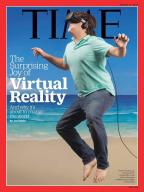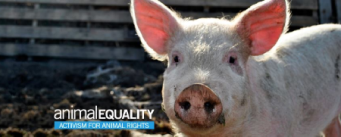
Image from Huffington Post
In September, I attended the First Human Behaviour Change for Animal Welfare conference. Animal Equality, the first animal protection group to transport people inside factory farms and slaughterhouses using virtual reality technology, presented their innovative product. Over three days, I never participated. If the viewer knows the immersion is ‘real’ and negative it got me thinking, can we change the world with…virtual reality?

Image from Time Magazine
Virtual reality is extensively blogged about by mainstream media. Increasingly so about its use and potential within social change campaigns.
- NBC News explores whether virtual reality can make you a better person.
- The Guardian provides readers with a starter guide ‘Engage your givers with virtual reality‘ showcasing five examples that aim to engage audiences in what is done.
- The BBC’s Taster (@BBCtaster) series has a whole category dedicated to virtual reality
- TED talks highlight various videos, including ‘How virtual reality can create the ultimate empathy machine‘ where you feel humanity in a different way.
Virtual reality is a technology worth considering within the tool-kit of a campaign communicator, if there is just cause it can best serve campaign objectives. Risks can arise with such innovations used for social impact.
Risks can be described as six ‘uncertainties’ (Seelos and Mair, 2016, p29) which can impact on effectiveness:
- Problem frame uncertainty challenges campaigners to ensure they truly understand the problem and root causes the campaign aims to solve.
- Solution uncertainty challenges campaigners to ensure they have the resources and these resource are designed for impact.
- Adoption uncertainty challenges campaigners to consider if the audience will engage, accept and implement your solution – especially if solution uncertainty has been overcome.
- Consequence uncertainty challenges campaigners to consider if their solution may produce negative side effects and perhaps, to what extent.
- Identity uncertainty challenges campaigners to affirm that they are committed to their solution, that it is strong enough and aligns with agreed and publicised purpose.
- Managerial uncertainty challenges campaigners to consider whether they can oversee the solution, productively, in an agreed timeframe – which ideally strategies should have.
A similar article by Innovation Excellence discusses uncertainties of innovation.
If uncertainties are adequately addressed, likelihood of success is greater.
I’d be curious in the development process taken by iAnimal. Watch and then consider how well Animal Equality has practiced innovation by overcoming uncertainties (Seelos and Mair, 2016, p33).
Did you watch?
Do you feel that Animal Equality has:

Image from Animal Rights UK
A clear objective for pursuing this innovation? Ask themselves meaningful questions about the problem, as they (and others) see it? Drawn on relevant knowledge? Formulated a hypothesis that virtual reality would alter how people view farm animal reality? Tested potential solutions in the real world?
One challenge in learning from others who campaign, is that strategies are kept secret. Did iAnimal consider adoption uncertainty enough, if people (like myself) were unwilling to immerse themselves in the pigs’ experiences?
Regardless of a success or failure, a series of assumptions about why are formed once the secrets are exposed. Campaigning, like innovation, is trial and error and require reflection and learning. It is risky business BUT social issues require it.
References
Seelos, C., Mair, J. (2016). Stanford Social Innovation Review: When Innovation Goes Wrong. Leland Stanford Jr. University. Available from https://ssir.org/articles/entry/when_innovation_goes_wrong. [Accessed 31 December 2016].
This blog is part of my MA in Media, Campaigns and Social Change with the University of Westminster.

I have been thinking about how virtual reality can work to enhance social change campaigns a lot recently, it is a topic I am very interested in! I never really considered adoption uncertainty in this way. I think it could be one of the greatest tools for empathy that a campaigner could ask for, but if your subject matter is sad or negative, or maybe hard to watch (such as your pig video which I could not bring myself to watch more than seconds of because I was imagining what may happen), people may just decide not to engage. That is a really challenging problem and I am interested to see if a solution can be found.
LikeLike
I agree with you, it can be a powerful tool. I suppose in this instance I already know what occurs on a factory farm having visited one in real life. I didn’t need to relive the experience. I can certainly see the benefits; such as letting people select meat from a supermarket and then being able to see what the lives of those animals are like. It could move people towards more welfare friendly choices. Thanks for your comment!
LikeLike
Just an addition that 360 video is now used in equine education:
http://www.equinechronicle.com/first-360-degree-virtual-reality-video-for-veterinary-education/
LikeLike